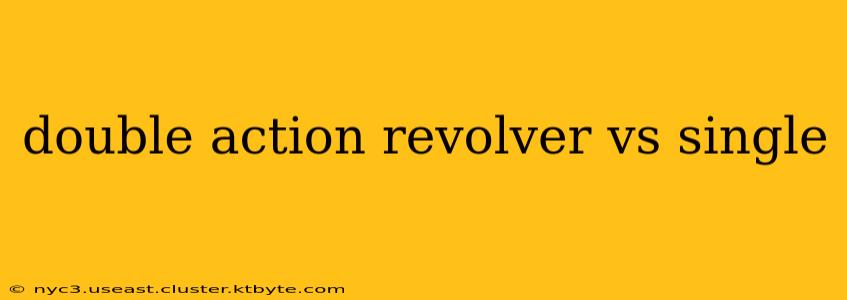Choosing between a double-action and a single-action revolver is a crucial decision for any shooter, whether you're a seasoned enthusiast or a first-time buyer. This comprehensive guide will delve into the key differences between these two revolver mechanisms, helping you determine which type best suits your needs and shooting style.
Understanding the Action: Double Action vs. Single Action
The core distinction lies in how the hammer interacts with the firearm's firing mechanism. This impacts how you cock the hammer and fire the weapon, influencing both speed and accuracy.
Single Action Revolvers:
- Mechanism: In single-action revolvers, you must manually cock the hammer back before each shot. This process also rotates the cylinder, aligning the next chamber with the barrel.
- Firing: Once the hammer is cocked, a single, light trigger pull fires the round.
- Advantages: Single-action revolvers generally offer a crisper, lighter trigger pull, leading to potentially greater accuracy, especially for target shooting. They are also often favored for their simpler mechanism and perceived reliability.
- Disadvantages: The need to manually cock the hammer significantly slows down firing speed, making them less suitable for self-defense situations where rapid firing is essential.
Double Action Revolvers:
- Mechanism: Double-action revolvers allow you to fire the weapon with a single, long trigger pull. This trigger pull performs two actions: cocking the hammer and releasing it to fire the round.
- Firing: No separate cocking is required; simply pull the trigger to fire.
- Advantages: Double-action revolvers are significantly faster to fire, making them ideal for self-defense or situations requiring rapid engagement. They offer more immediate readiness, as the hammer doesn't need to be manually cocked.
- Disadvantages: The longer, heavier trigger pull in double-action revolvers can impact accuracy, particularly for less experienced shooters. The added mechanical complexity can potentially lead to slightly increased maintenance needs.
Beyond the Action: Other Key Considerations
While the action type is the primary difference, several other factors influence your choice:
1. Intended Use:
- Self-defense: Double-action revolvers generally excel in self-defense scenarios due to their faster firing capability.
- Target shooting/competition: Single-action revolvers, with their lighter trigger pull, tend to be preferred for precision shooting.
- Hunting/plinking: Both types can be suitable, depending on the specific hunting style or plinking preference.
2. Trigger Pull:
- Single Action: Lighter, crisper, more precise trigger pull, better for accuracy.
- Double Action: Longer, heavier, less precise trigger pull; good for rapid firing but potentially less accurate.
3. Ease of Use:
- Single Action: Requires more training and practice to master the manual cocking.
- Double Action: Easier to learn and use, particularly for beginners.
4. Maintenance:
- Single Action: Generally requires less maintenance due to a simpler mechanism.
- Double Action: May need slightly more attention due to the more complex internal parts.
5. Cost:
Prices for both single-action and double-action revolvers vary widely depending on brand, caliber, and features. It's best to research specific models to compare pricing.
Conclusion: Choosing the Right Revolver
The best revolver for you depends entirely on your individual needs and preferences. Consider your intended use, shooting experience, and desired level of accuracy when making your decision. Both single-action and double-action revolvers have their strengths and weaknesses; understanding these differences is key to selecting the perfect firearm for your purposes. If you are unsure, seeking guidance from a knowledgeable firearms expert is always recommended.

